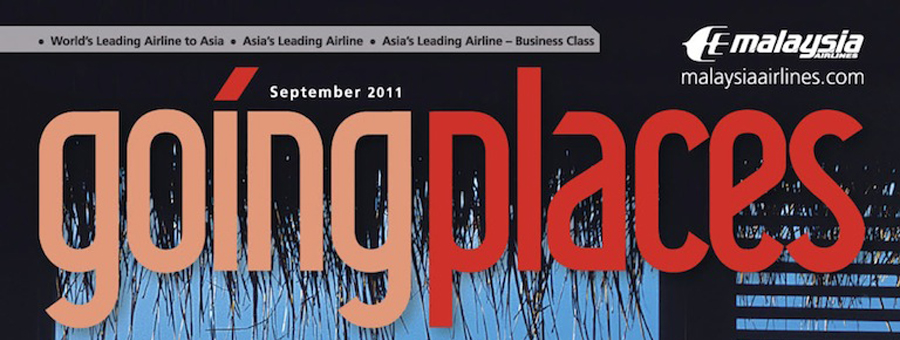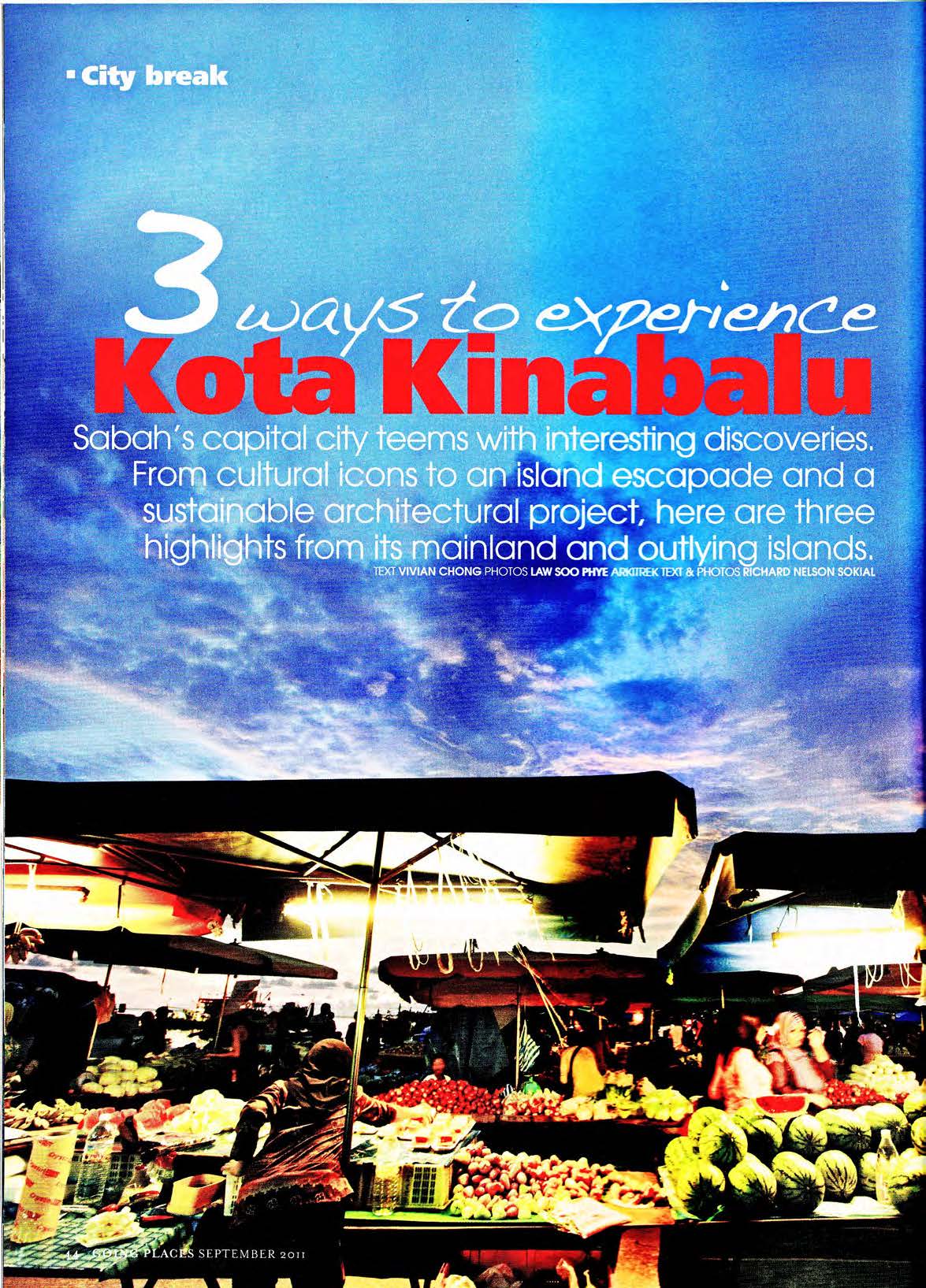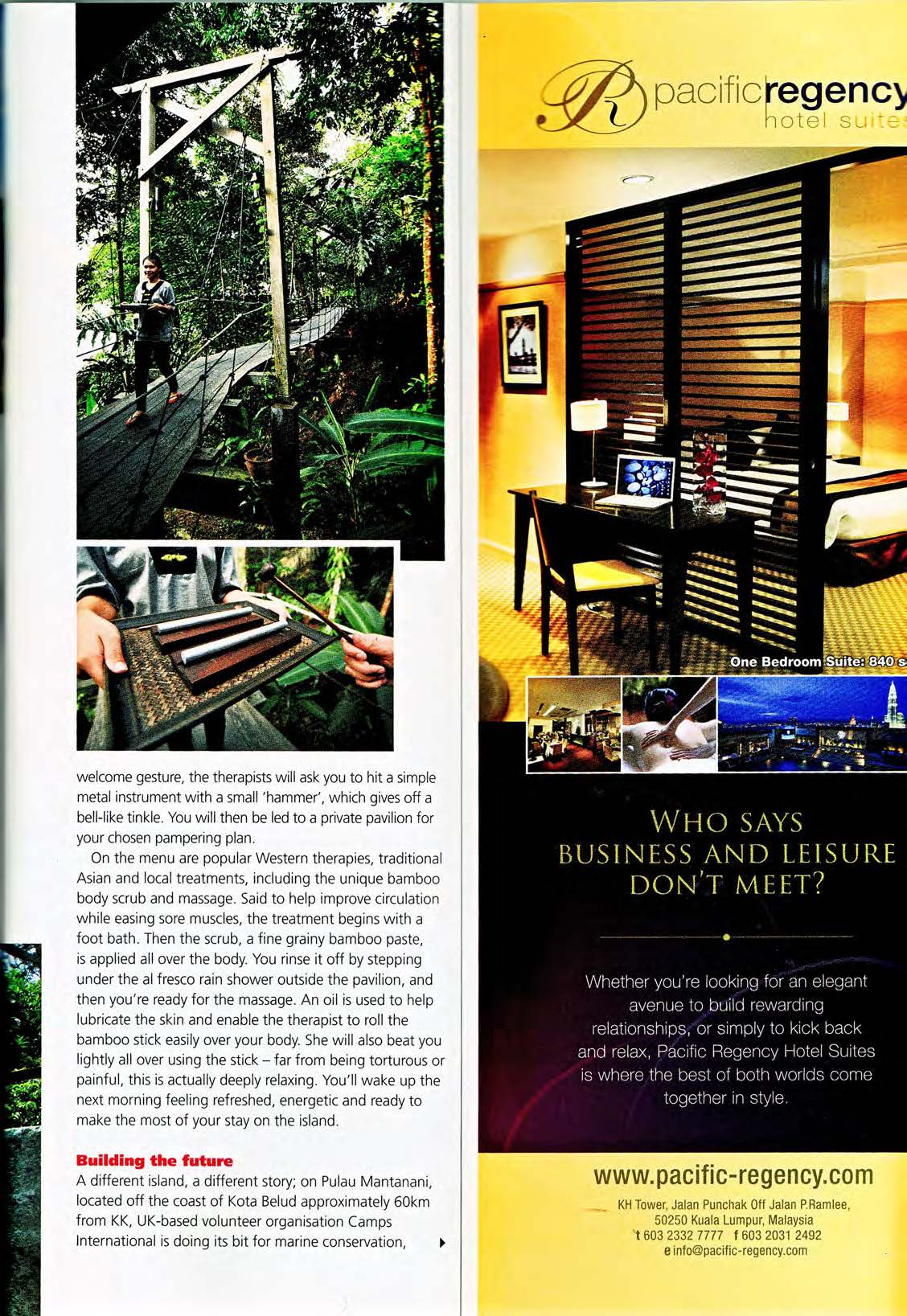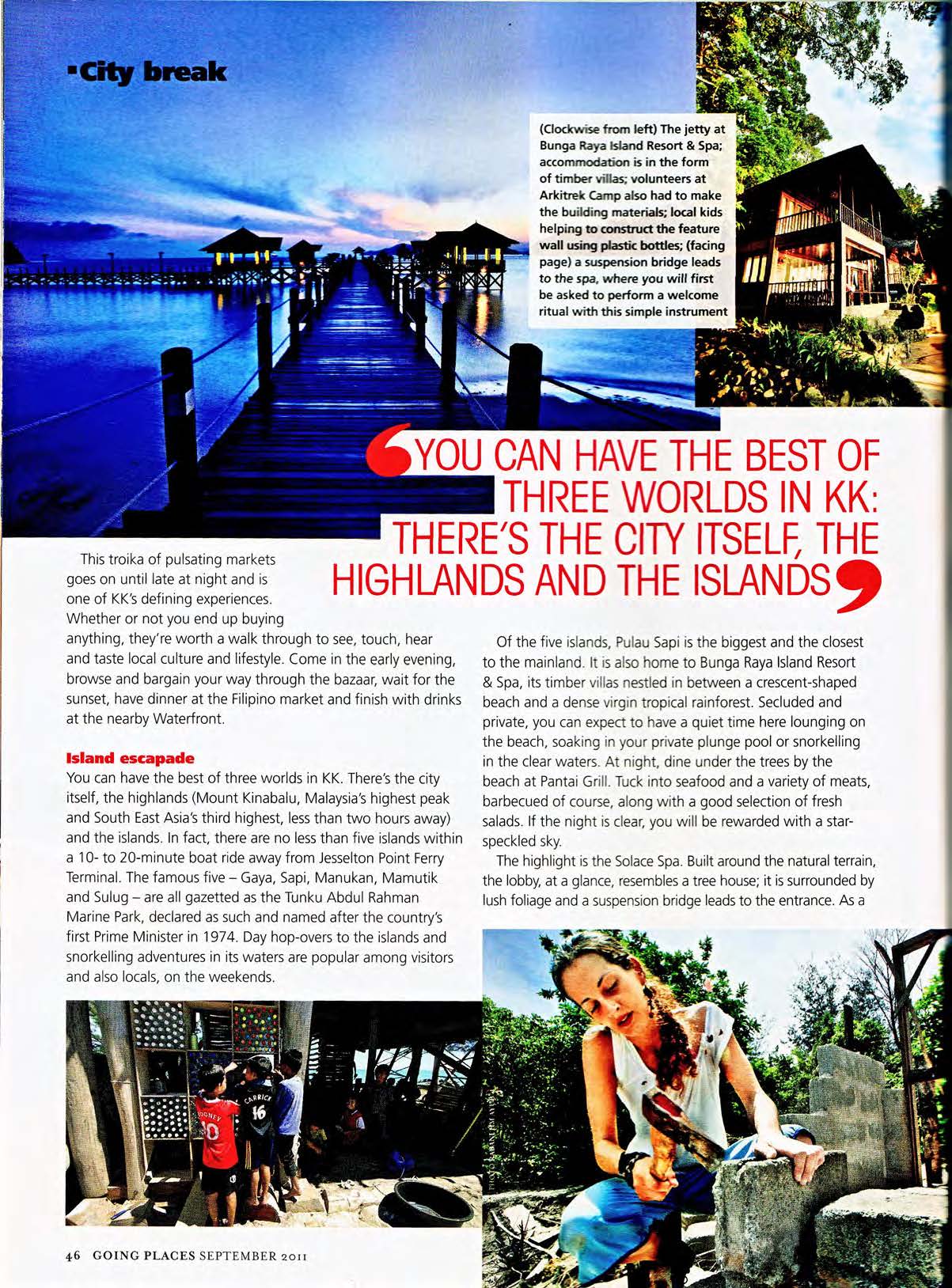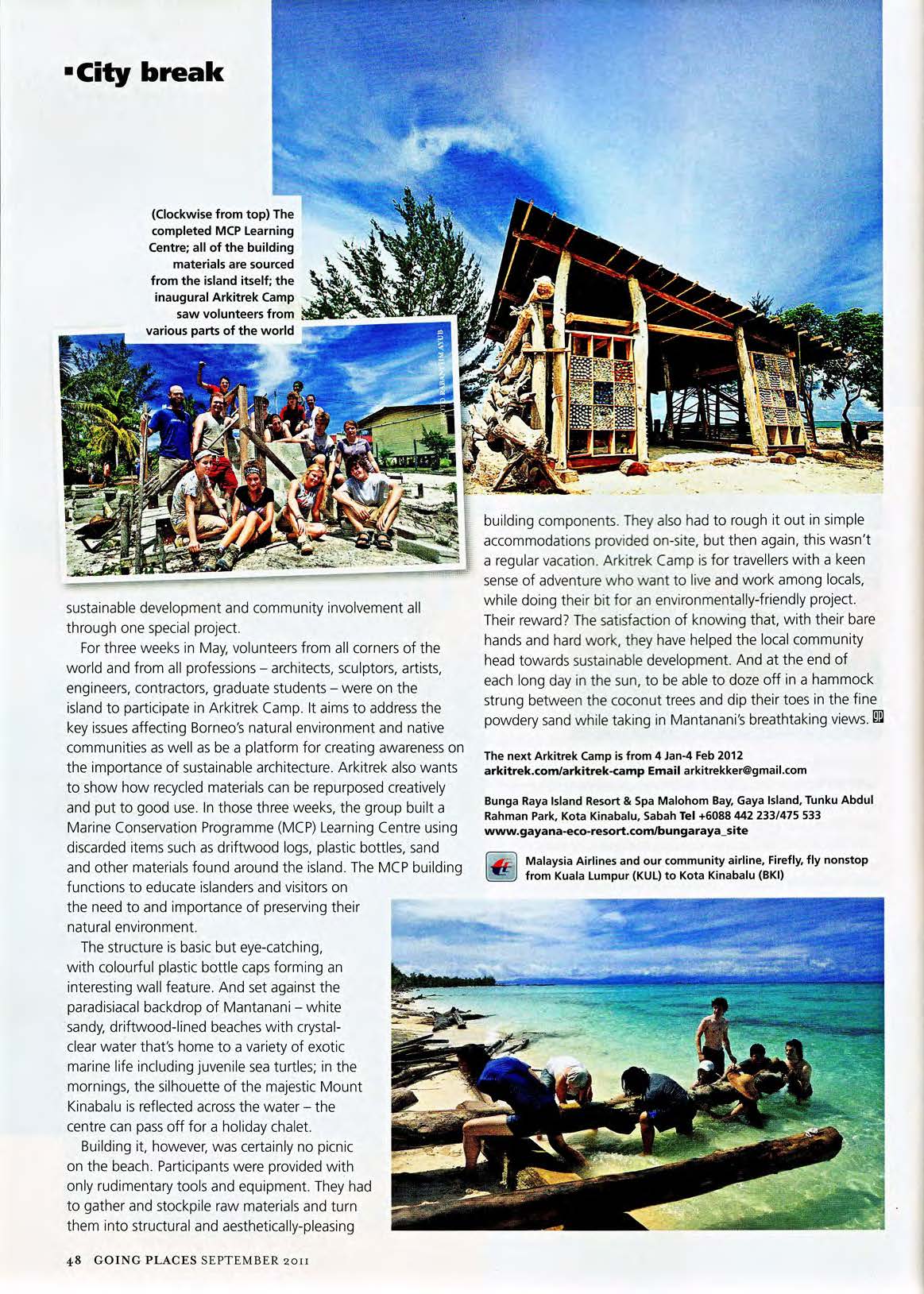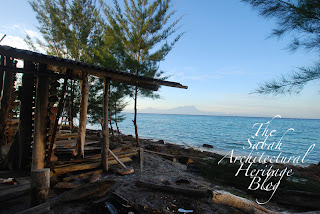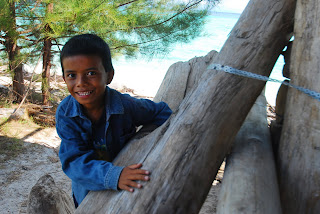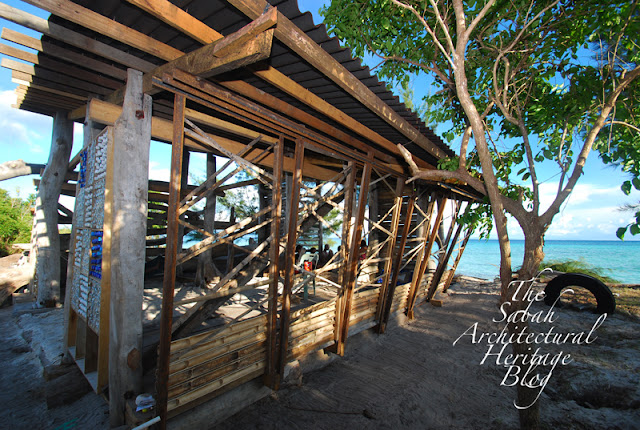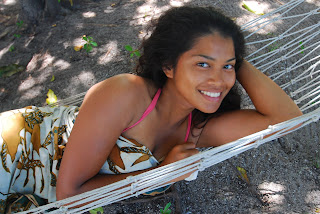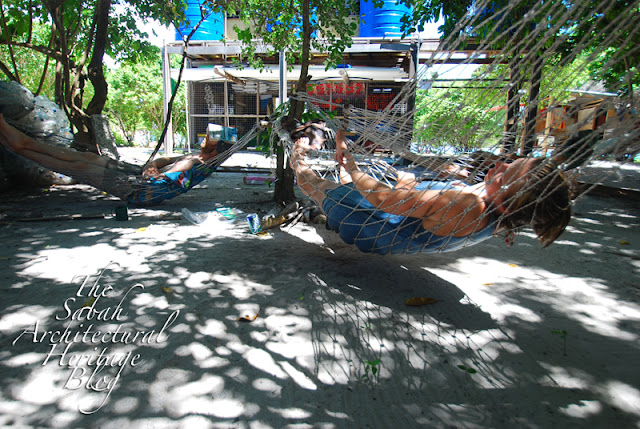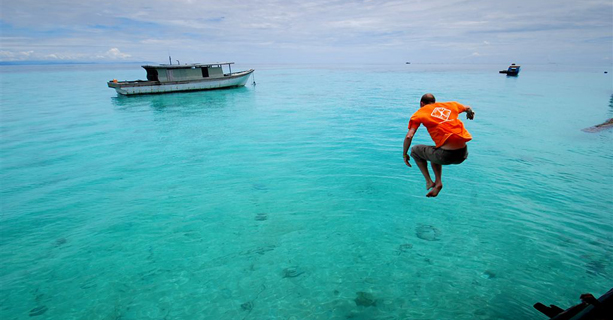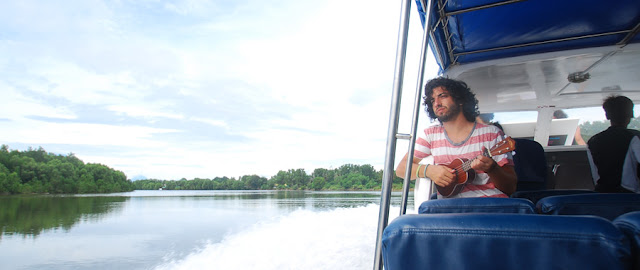Arkitrek Camp – Mantanani island 2011 (Conclusion)
Arkitrek Camp – Blog series by Richard Nelson Sokial (Part 5 of 5)
Original post can be found at the Sabah Architectural Heritage Blog
Just a typical morning on Mantanani island…
We had two days left to finish the MCP Learning Centre (the official name for Albi’s Chicken House).
It was crunch time – we knew it and everyone had their pokerface on as we silently ate our breakfast.
The Arkitrekkers had put up the roof the night before. Today, we had to finish the bottle wall, slanting bamboo wall elevation, floors and the massive driftwood wall on the east elevation.
Sarah’s illustrations of the interlocking driftwood wall. The boys joked that the drawings looked like trees in compromising positions.
“Kamasutra for trees”. LOL.
The two gappers had to leave the island early. Farewell, Jack and David B – thank you so much!
…but Ian came back and we were joined by Anna and Fraser, friends of David A. from UK.
Being put in charge of completing the bottle walls, I was feeling a bit under pressure. Albi – our key construction guy and expert with the chainsaw, had taken ill and was not able to cut the timber pieces that I needed for the original bottle wall design.
Pieces of leftover plywood from the camp’s previous projects were to be used instead of sawn planks.
This meant that the original wall design had to be simplified.
Meanwhile, Fraser, Anna, Pui Cheng and Michelle were cutting bamboo and figuring out how to put the slanted wall frames together.
The boys – Zee, David and Daniele were working hard on completing the building’s raised timber decks, while Pui Cheng and Ian were deciding how to put the driftwood wall together. Will was busy hammering pieces of driftwood onto the posts to complete the elevation facing the sea while Tina was working with Albi to drill the metal brackets holding the slanted walls.
Zee, David A and Will helping Ian and Hasheem lift a driftwood log into place.
Come noon and the Arkitrekkers were 80% finished with the building. The kids from Albi’s village had come out and watched with curious fascination as the Arkitrekkers raced against the clock to get the building done.
I saw an opportunity to utilize their little hands and roped in the kids to help complete the bottle walls. Giving clear instructions to them, the Mantanani children – led by Idham, Fadli and little Epot formed a mini crew of bottle outsourcers, bottle washers and bottle stuffers – as we systematically filled up the walls with plastic bottles that had been found on the beach and collected by the volunteers at Camp Mantanani.
The island kids were extremely enthusiastic about being part of this project – and I believe that it gave them a better sense of awareness, ownership and pride over this building – that would be handed over to them once the Arkitrekkers were gone.
The artistic effect of the bottle wall is a way of conveying new ideas of how the Mantanani people could make something pretty out of stuff they would have normally thrown away.
(Click to enlarge photo)
Aesthetically pleasing…but at the same time scary – just imagine how many discarded plastic bottles are thrown into the world’s oceans each day? Something to think about.
Everyone loved the hammock that Michelle designed and made. Bravo!
Meanwhile, the driftwood wall was finally finished and as the final reinforcing steel nut was screwed in, the kids had already started to climb onto the wall like a jungle gym.
Later, the bamboo walls that Fraser and the girls made were installed. The walls worked worked perfectly and were very comfortable to rest against.
We finished the timber deck floor just as Camp Mantanani’s staff showed up with cakes and tea.
Food!
Hooray, we finished the building!
Albi’s Chicken House was now officially completed! Well done Arkitrekkers!
That evening, the whole group celebrated their first night in Albi’s Chicken House with rice, barbecued chicken and lamb. Aida was the main chef. We made a huge bonfire from the pieces of rotten driftwood that we had cleared from the site.
Later, Aida took out a laptop and we looked at the photos showing the development process of the building that we had just built.
The finished building was kinda awesome actually.
After dinner, some of us decided to sleep in Albi’s Chicken House instead of our regular hammocks at camp. It rained heavily that night, the heaviest that we had ever experienced in our two weeks on the island. I guess it’s the universe’s way of testing our building. LOL.
Note: It was nice to find out later from Ian that Albi had commented that he had found a genuine appreciation for the Arkitrekkers and said he even learnt a few things from us as well. Hasheem had already booked his spot to nap in Albi’s Chicken House, and Mel was elated that Camp Borneo now had a proper place to conduct activities on Mantanani.
The building would be the first phase of Camp Borneo’s collaboration with Arkitrek, the next being an extension to the building with a shop for selling local island products such as driftwood sculptures, etc. I can already foresee Albi’s Chicken House as a meeting point for not only Camp Borneo’s volunteers but also for a ‘bridge’ for the two village communities living on the island.
Saying goodbye to Albi’s Chicken House…
Leaving Mantanani the next morning, we took our final photos as remembrance of the Arkitrek Camp experience. While several of us will have the chance to come back and see how the building has matured over time, some of the participants may never be able to visit this building again.
I am posting up my notes as a shout out to those awesome individuals of the first Arkitrek Camp, to remind them from time to time of what we achieved as a team – and that when enough like-minded people get together, we can make a difference in the world we live in.
It was a pleasure and honour to have been part of the first Arkitrek Camp and my salutes to everyone who was involved in it; Arkitrek Founder Ian Hall, Melanie Chu, Sarah Greenlees, Daniele Cohen, Pui Cheng (who never got called by her first name Vivian), Zee, David Arnott, Will Smith, Tina Celestial, Kitler the cat, Michelle Martin, David Beattie, Jack Allcock, Anna and Fraser, Yanti Saman, Albi and family, Hasheem, members of the Malaysian Police force on Mantanani (who helped us pull most of the heaviest driftwood) and last but not least the awesome Aida Rahman and her ukelele.
Three cheers for Arkitrek Camp
Related posts
%RELATEDPOSTS%
Arkitrek Camp – Mantanani 2011 (Part 4)
Arkitrek Camp – Blog series by Richard Nelson Sokial (Part 4 of 5)
Original post can be found at the Sabah Architectural Heritage Blog
Little by little, the Marine Conservation Programme Learning Centre building (the Arkitrekkers refer to it as Albi’s Chicken House) starts to take shape.
The absence of sporadic BUUURP! sounds around the vicinity of Camp Mantanani was an indication that Ian Hall had gone back to Kota Kinabalu on official business for a few days.
Meanwhile, I returned to the island with two gappers from UK – Jack and David B. The boys were fresh hungover fresh from their stay at Tinangol village in Kudat and were looking forward to doing something interesting during their stay at Mantanani.
In my absence, the rest of the Arkitrek Camp’s team had completed the building’s foundation and post structures – and were looking to putting up the rafters as soon as possible.
Living on an island for 2 weeks and working in a construction site doesn’t give anyone a lot of room to be glamorous.
Take Tina for example.
From this…
…to this. Hahaha.
Pui Cheng, on the other hand, was all business.
From this…
…to this!
She was in charge of gathering our driftwood and became a bit obsessed with her stockpile of logs.
See?! Hoarder. I’m pretty sure she was a magpie in a past life. LOL.
Life on an island makes you do strange things.
6-foot tall Sarah was always hungry. At one point during work, I was covered in sawdust – and she lurched over and told me that I looked like a biscuit. I was very scared.
Michelle had a close encounter with one of the island’s most notorious creatures; heard strange munching noises outside her tent one night, poked her head out – and found herself looking at a very surprised cow. Hee.
Boys gone wild!
Will gets jiggy with a pole.
Daniele wants to be a monkey.
David A…just wants to be…pretty.
I was the camp klutz, getting whacked on the head by a piece of driftwood and tripping over myself on several occasions at work. Aida was probably on Orange Alert whenever I stepped onto site. Being so accident-prone annoyed me immensely cos I’m usually awesome and stuff.
Apart from me and the one-time that Zee whacked his thumb with a hammer whilst fixing the roof, there were no occurrences of mishaps on-site as we adhered to the general safety guidelines that the camp facilitators had established before work commenced.
Plus, we were well protected.
Yellow hardhats – courtesy of Arkitrek!<
But after more than a week of doing hard labour, it was clear that the Arkitrekkers needed to have a proper break from work – to chill out and revel in the fact that we were on a beautiful island in the South China Sea.
Daniele and Sarah made us all take a half-day break. The boys grabbed their flippers and went swimming out to nearby Linggisan island while I rented a kayak and roped in gapper Jack to go kayaking with me. The plan was to meet the boys on the island.
However, neither Jack nor I had ever kayaked before around Mantanani – and as you might expect, the two of us found ourselves stuck in the middle of a maze of coral reefs as we tried to paddle to Linggisan island! Crap!
Also, we also discovered that our kayak was taking in water. The imbalance in the kayak’s hull threatening to throw both of us – and all our stuff – into the water. By some miracle, we managed to pry ourselves out of the treacherous labyrinth of dead corals and make our way to Linggisan island.
Bare footprints in the sand told us that the boys had gone exploring the island. Gingerly, Jack and I traced their steps across a series of sharp rocks – where hoards of small, cockroach-like shrimp creatures scattered away each time we walked past. Creepy buggers.
We finally found the boys – and Pui Cheng – outside the entrance of the big cave at Linggisan Island. It was the most beautiful cave I have ever seen- an almost perfectly symmetrical grotto carved out from coral rock that made up most of Linggisan’s geological features. Above the cave – suspended in mid-air – were shady trees that gripped precariously to the bits of jagged rocks. The cave on Linggisan island was home to an endangered species of frigate birds and a colony of bats. The island was breathtaking. Spooky, but magical.
[The birds in the cave are German’s Nest Swiftlets. The Frigate Birds roost in the trees on top of the island. Ed]
The sun was going down. Jack and I decided to head back to the beach on our kayak; we would meet the others at the rendezvous point on Mantanani at the abandoned resort facing Linggisan island. In order to stabilize the water-addled kayak, I jumped into the sea and clung onto the rear end of the craft while Jack valiantly paddled us to shore. We only learned later that we didn’t plug the kayak properly, hence the reason why we were sinking the entire time. Noobs.
Judging from the insanely low tide occurring in the day, I had a feeling that there would be a full moon on Mantanani that night. And lo behold, as we reached the shoreline, a huge, yellowish full moon was peeking out from behind the island’s silhouette of trees.
Sarah and the girls had prepared a nice campfire on the beach. Zee was lying in the sand, admiring his abs. Pui Cheng took a while to let go of her driftwood-hoarding obsession; we caught her piling up sausages in a plate and leaving them by the fire, uneaten. Daniele and I played the ukelele and sang a hundred songs with the chords of C Am F G. Our usually soft-spoken Michelle was a laugh riot – and shall forever be remembered for describing our dinner as “tast(ing) like potato salad from home, but defferent”. The two Davids (A & B) were spiking Coca-cola with Gay Rum and passing them around while Aida and Tina took our now-buoyant kayak out for a spin. Of course, it started to rain and everyone ran back to camp, leaving Aida and Tina floating on the sea. LOL.
Of course, we all made it home safely.
It was a wonderful evening, full of adventures, good company – and of course, potato salad (but different, from home).
I’ll post up the last part of the Arkitrek Camp – Mantanani 2011 tomorrow.
Related posts
%RELATEDPOSTS%
Arkitrek Camp – Mantanani island 2011 (Part 3)
Arkitrek Camp – Blog series by Richard Nelson Sokial (Part 3 of 5)
Original post can be found at the Sabah Architectural Heritage Blog
Camp Mantanani needed an architecturally inspiring new building as their marine conservation centre-cum-learning centre-cum playground for the kids of Mantanani island.
The Arkitrekkers had a little over 2 weeks to come up with a building that satisfied that brief.
Here’s our project site.
Over the next several days, the participants designed, brainstormed and presented their ideas in group discussions over what would be the best approach to designing this building.
We gathered suitable driftwood – and pushed…pushed…PUSHED! it all the way back to the project site.
Luckily for us, driftwood…well, kinda…drifts…
But it still took a lotta work to get the desired pieces onto site.
Nevertheless, it wasn’t the worst job in the world. Far from it…
…we all got to snooze after lunch…
“Erm…Ian, there’s a shoe on your head.”

Ian: I know, but resting in a hammock on a tropical island makes me feel so sleefffy*zzzZZZzzz..
So, the Arkitrekkers finally amass enough lumber/driftwood to start construction. Apart from four concrete stumps (for a future shop structure), the overall foundation design for the building is actually an arrangement of driftwood logs laid on the ground. The main posts are cut, notched and placed onto these ‘pads’ with additional support of dimension timber, also placed on top of the driftwood pad.
As Michelle our Arkitrekker would probably say…
The group had decided to build a single pitch roof structure slanting westwards at 13.5o, with a raised floor on one side and a hammock on the other. There would also be a wooden deck built facing towards the beachfront.
Actually, the overall design concept is a bit more comprehensive and thought-out…I’m just simplifying my descriptions in layman terms in order to fit everything into this blog post. Sorry guys – hope that’s okay.
There would be a ‘bottle wall’ at the entrance of the building and a slanting wall on the west elevation. The east side elevation would be a driftwood wall feature – made from large driftwood logs stacked on top of each other.
Onduline sponsored the roofing material.
…and Albi’s brother, Hasheem was the main man in charge of putting the roof on.
Hey there, Hasheem!
On hindsight, it was an ambitious project, purely because of the logistics, time constraints as well as material limitations required to complete the task.
But since the Arkitrekkers (and Albi and Hasheem and Aida) were awesome, we managed to pull it off.
Hee.
Anyway…
(Left) Driftwood posts being erected. (Right) Will holds a timber rafter while Zee, David and Sarah assess from below. Tina, Michelle and Daniele work in the background. Pui Cheng is not in the photo…most likely she’s wandered off somewhere, looking for more driftwood.
Designing and constructing the building proved to be a physical and mental challenge for every member of the Arkitrek Camp. Not only did the group have to contend with lifting heavy construction materials a.k.a driftwood logs but also putting up with the hot, scorching sun that bore down mercilessly on us daily from 9.30am till noon!
As Aida will attest, it was hot enough to boil an egg! In the sun!
(Translation) Pui Cheng: Albi, we’re going to keep this wood to make…
Albi: …chicken house…
Albi did not seem impressed with our design skills at the time. He kept referring to our building as a ‘chicken house’. LOL.
We were always relieved when the day came to an end. Most evenings, we would just jump into the sea to relax, but as the moon was waxing, the tide was getting very low as the days progressed.
However, we did take some time off to explore our surroundings. There are two villages on Mantanani – one at each side of the longish-shaped island. An abandoned resort and a police outpost is located at the village facing westward towards Linggisan island, while the other – Albi’s village – is located on the opposite end where the primary school is located.
View of Linggisan island from the village, west of Mantanani.
A kindergarten project under Arkitrek is currently underway near the Mantanani primary school.
There are also a lot of cows on the island.
Mt. Kinabalu can clearly be seen from Mantanani island.
I shot this panorama right after taking the previous photo of Mt. Kinabalu. Amazing sunset hues at Mantanani.
I had to return to KK city for a few days to settle some prior work commitments.
Meanwhile…
Sarah celebrated her birthday on site with the Arkitrekkers at Mantanani…
…the group got bored and started racing hermit crabs…
…and of course, they continued working on the building…
…then I came back to the island and it was awesome. LOL.
I will update this blog again tomorrow.
Stay tuned for Part 4 and conclusion of the Arkitrek Camp – Mantanani 2011 experience.
Related posts
%RELATEDPOSTS%
Arkitrek Camp – Mantanani Island 2011 (Part 2)
Arkitrek Camp – Blog series by Richard Nelson Sokial (Part 2 of 5)
Original post can be found at the Sabah Architectural Heritage Blog
It was barely daybreak when the bus came to pick us up from Kipouvo village. I followed Ian into KK city to tie up a few loose ends before joining the others as we took to the road in the direction of Kuala Abai, where a speedboat was awaiting our arrival.

We were joined by Melanie Chu, General Manager at Camp Borneo. Also on the trip was Aida Rahman, the rasta-haired Camp Manager for Camp Mantanani (under Camp Borneo).
The journey to Mantanani took approximately 45 minutes by speedboat – passing through scenic mangrove tributaries and a village at the rivermouth, before heading out to the open sea.
I noticed that Aida, Melanie and Daniele had all brought along what seemed like miniature toy guitars on this trip. As it turns out, these ‘toy guitars’ were actually Ukeleles. Aida says that Ukeleles are becoming a ‘thing’ on Mantanani.
Of course, my imagination went into overdrive…
A sliver of deep blue clusters soon appeared on the ocean horizon, giving us our first glimpse of Mantanani island. Soon, we reached the shallows of the beach – where everyone gasped in collective awe at the sight of the island’s raw beauty.
“OMG, look at the water!”
The amazing crystal-clear quality of Mantanani’s seawater, waist deep over a white sandy seabed captivated all of us newcomers to the island. My first instinct was to just jump in; alas I remembered that my handphone did not swim very well.
Camp Mantanani’s staff were on hand to help us off the boat and took our supplies onto shore.
We were introduced to Albi and his family, who help to run Camp Mantanani when youth groups visit the island for Camp Borneo’s activities. Albi is also the headman of the village where Camp Mantanani and the Arkitrek Camp’s project site are situated.
Aida and Albi took us to visit his village.
According to Aida, the island is inhabited by fishermen from the Ubian ethnic group, with a population of approximately 800 people. The Mantanani islanders make some minimal wages drying salted fish and selling it to the mainland towns in Kota Belud.
That’s a lotta dried fish.
Albi doing his village headman pose in front of the school.
Aida and Mel saying ‘Helloo’ to the locals.
Just me in a Mantanani boat house, being awesome.
The crystal-clear water proved too much to resist…
…jump!
…Woo hoo!
…marvellous!
It was bound to happen at some point. Haha.
After throwing ourselves off Albi’s village jetty, we went back to camp for Mel and Aida’s briefing in regards to what they wanted the Arkitrek Camp participants to build. Camp Mantanani hoped to establish a marine conservation centre on the island to facilitate not only the activities of future camp participants but also a learning centre-cum-kid’s playground for the island community.
Our site was a kid’s playpen-with-tower known as ‘The Magellan’ that was built by past Camp Borneo participants.
Mel and Aida gave us an open-ended brief to re-use the structure or tear it down for the new building. We opted for the latter.
On the top left, is the sandy path that links the two villages on Mantanani island.
We were sad to learn from Aida that the rare and friendly Dugongs that once frequented the island to graze on the sea grass had now disappeared, most likely because of the fish bombing activities that are still prevalent in the waters around Mantanani.
Aida also explained several other key challenges affecting the social and economic status of the island people.
Rubbish washed up on the beaches of Mantanani is also an ongoing problem. Some of it is thrown away by the island’s inhabitants. Some floating debris finds its way to Mantanani’s beaches from the mainland, while other floating garbage is carried by sea currents from other places to the island.
We even found a plastic bottle from Thailand. Imagine that.
Camp Mantanani hopes to establish a place to promote marine conservation awareness amongst the Mantanani villagers so that they can provide better stewardship for the island for years to come.
As participants and volunteers, we realised that our project – if we succeeded – would be a catalyst for the aspirations of Camp Mantanani. It would empower the villagers of Mantanani to take ownership of their environment and to manage it sustainably, making use of materials that they never thought could be used for buildings.
As a group of young architects and designers, Mel threw us the gauntlet: To design an architecturally iconic learning centre and playground for the village children and visitors to Mantanani, using driftwood and other suitable materials salvaged from the beaches of Mantanani.
Were the arkitrekkers up for the challenge?
Related posts
%RELATEDPOSTS%

